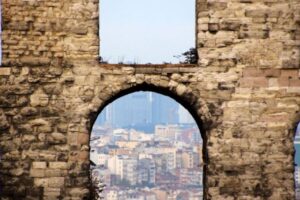Aqueduct of Valens in Istanbul (Bozdoğan Su Kemeri)

The Aqueduct of Valens stands majestically over the hustle and bustle of Atatürk Bulvarı. The traffic below is constant, making the contrast between the historic aqueduct and modern-day Istanbul even more impressive.
The Aqueduct of Valens or Bozdoğan Su kemeri on Turkish was built in late 4th century AD as a system to supply Constantinople with water from Belgrad forest.
The aqueduct was made from stone and bricks and it’s total length was 971 m.
Today we can see this unique structure crossing Fatih district and Ataturk bulvar under aqueduct’s arches.
The history of the Aqueduct of Valens

Aqueduct of Valens Istanbul
The structure was built by the Romans, who constructed an aqueduct system to bring water into the city and people. The Aqueduct of Valens was constructed in the late 4th century AD. At the time, it supplied Constantinople with water. It was the chief city of Roma’s eastern empire before being taken over by the Ottomans.
Building on the Aqueduct of Valens started under the reign of Constantius II. He was Roman emperor from 337 to 361. It was later completed by Emperor Valens in 373. It is Valens’ reign that the name of the aqueduct was given.
Various rulers continued the maintenance and expansion of the aqueduct to provide water to the city. In 382, after Constantinople experienced a severe drought, the aqueduct received expansion under the rule of Theodosius I. In 626, the aqueduct was destroyed during a siege by the Avars. Due to its importance, it was rebuilt in the 8th century.
The aqueduct was extremely significant to the city of Constantinople and Istanbul after the Ottomans took control. It was used for centuries and was maintained by both the Byzantines and Ottomans once they ruled over the city. The Aqueduct of Valens was still in use until the late 1800s.
What is the Aqueduct of Valens?
The aqueduct is two-storeys in height. At its highest point, the aqueduct stands twenty metres tall and possesses Roman arches. The arches run the entire length of the aqueduct. When the Aqueduct of Valens was originally constructed, it was nearly one kilometre in length. It spanned the valley between Constantinople’s third and fourth hills. Occupying those hills today are Istanbul University and the Fatih Mosque.
Today, there are parts of the Aqueduct of Valens that are missing. There is still nine hundred and twenty metres available for tourists to visit and explore and it is one of Istanbul’s most historic aqueducts.
The structure was a portion of the longest single ancient aqueduct system ever built to supply water to Constantinople. Beginning around Bizye (modern Vize) and stretching to Constantinople, the long-distance aqueduct was more than 250 kilometres in length.
It covered a diverse landscape and travelled across more than 30 bridges. The aqueduct system also went through underground tunnels to reach the Aqueduct of Valens Bridge in the middle of the city.
Is the Aqueduct of Valens still in use?
The aqueduct is not in use nowadays but most of the constuction is still in good condition so you can look and imagine how it worked.
How did Constantinople get water?
The Aqueduct of Valens brought the water from Belgrad forest (Belgrad ormanı) to Constantinople with it’s cisterns, baths, fountains and reservoirs
Visiting the Aqueduct of Valens

Aqueduct of Valens Istanbul
The Aqueduct of Valens Bridge was restored by Mustafa II in the late 17th century. Had the Ottoman ruler not ordered the restoration of the Valens Aqueduct Bridge, it may not have been persevered for present day viewing. The surviving portion of the aqueduct is a distinctive landmark in Istanbul as every-day traffic passes between its arches.
The portion of the Aqueduct of Valens that is located on Atatürk Bulvarı was modernised by the Istanbul Metropolitan Municipality in 1988. It was later restored between 1990 and 1993 to its modern-day look.
The aqueduct is easy to visit and one of the most significant historical landmarks in the city. It can be visited by passing under the Aqueduct of Valens Bridge while travelling on Atatürk Bulvarı. Of course, visitors can get out of their car in the area and take a much deeper look at the aqueduct, which is free to view and snap pictures of.
Landmarks and tourist sites near the Aqueduct of Valens
Unfortunately, while it is a great landmark to view and take pictures next to, there isn’t much else to do around the Valens Aqueduct. You are not able to climb and walk the length of the aqueduct. Although you may see some locals climbing it and walking on the aqueduct, it is prohibited by local law to do so.
Visitors can retreat to the Fatih Anik Parki, a nearby park, to explore the area further. The Sehzade (Prince’s) Mosque and the Bimali Cami are also nearby, and both are popular tourist attractions. If you visit the Sehzade Mosque, you can view the aqueduct from a different angle and away from the traffic that drives under its arches.
Culture vultures may want to seek out the nearby Zeyrek Mosque. It provides a grand example of Byzantine architecture. There are also plenty of local restaurants to discover while wandering through the area.

Pingback: Skidson
Pingback: My Site